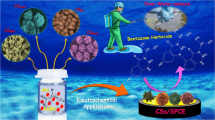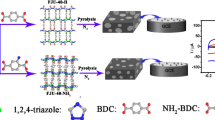Abstract
Different morphology of N-doped carbon materials, including three-dimensional interconnected N-doped hierarchically porous carbon networks (3D-NC), two-dimensional ultrathin porous carbon nanosheets (2D-NC), and bulk N-doped carbon with micron size (bulk-NC), was easily prepared by using NaCl crystal templates–assisted strategy. Compared with bare glassy carbon, bulk-NC, and 2D-NC, the as-synthesized 3D-NC exhibits excellent electrochemical activity toward the oxidation and sensing of three kinds of common environmental pollutants dihydroxybenzene isomers (hydroquinone (HQ), catechol (CC), and resorcinol (RS)). The impressive electrochemical activity of 3D-NC can be interpreted by its large specific surface area, continuous network-like morphology, superior electro-catalytic ability, and strong accumulation efficiency. Differential pulse voltammetry (DPV) test showed the 3D-NC-modified electrode exhibited three well-separated oxidation peaks at 0.05 V, 0.14 V, and 0.45 V vs. saturated calomel electrode (SCE) for HQ, CC, and RS, and their detection limits were evaluated to be as low as 0.0044, 0.012, and 0.016 mg L−1, respectively. Finally, a novel electrochemical analytical platform is successfully fabricated for the simultaneous monitoring of hydroquinone, catechol, and resorcinol with high sensitivity. When used for real wastewater samples analysis, recovery ratio ranging from 94 to 108% with lower than 5% of relative standard deviation (RSD) values was achieved. This work proves a facile strategy to prepare morphology-controlled N-doped carbon-based material and demonstrates its high application potential for environmental monitoring and electrochemical analysis.
Graphical abstract







Similar content being viewed by others
References
Gan T, Wang Z, Gao J, Sun J, Wu K, Wang H, Liu Y (2019) Morphology-dependent electrochemical activity of Cu2O polyhedrons and construction of sensor for simultaneous determination of phenolic compounds with graphene oxide as reinforcement. Sens Actuat B-Chem 282:549–558. https://doi.org/10.1016/j.snb.2018.11.102
Long L, Liu H, Liu X, Chen L, Wang S, Liu C, Dong S, Jia J (2020) Co-embedded N-doped hierarchical carbon arrays with boosting electrocatalytic activity for in situ electrochemical detection of H2O2. Sens Actuat B-Chem 318:128242. https://doi.org/10.1016/j.snb.2020.128242
Sun J, Xu L, Shi Z, Zhao Q, Wang H, Gan T (2021) Morphology-tunable hollow Mn2O3 nanostructures: highly efficient electrocatalysts and their electrochemical sensing for phenolic endocrine disruptors via toughening of graphene oxide. Sens Actuat B-Chem 327:128889. https://doi.org/10.1016/j.snb.2020.128889
Wang Y, Tao L, Xiao Z, Chen R, Jiang Z, Wang S (2018) 3d carbon electrocatalysts in situ constructed by defect-rich nanosheets and polyhedrons from NaCl-sealed zeolitic imidazolate frameworks. Adv Funct Mater 28(11):1705356. https://doi.org/10.1002/adfm.201705356
Zhang Y, Wan Q, Yang N (2019) Recent advances of porous graphene: synthesis, functionalization, and electrochemical applications. Small 15(48):1903780. https://doi.org/10.1002/smll.201903780
Tian W, Zhang H, Duan X, Sun H, Shao G, Wang S (2020) Porous carbons: structure-oriented design and versatile applications. Adv Funct Mater 30(17):1909265. https://doi.org/10.1002/adfm.201909265
Liu C, Li Q, Kang W, Lei W, Wang X, Lu C, Naebe M (2022) Structural design and mechanism analysis of hierarchically porous carbon fiber for advanced energy and environmental applications. J Mater Chem A 10:10–49. https://doi.org/10.1039/D1TA08646D
Xie L, Su F, Xie L, Guo X, Wang Z, Kong Q, Sun G, Ahmad A, Li X, Yi Z (2020) Effect of pore structure and doping species on charge storage mechanisms in porous carbon-based supercapacitors. Mater Chem Front 4(9):2610–2634. https://doi.org/10.1039/D0QM00180E
Inagaki M, Toyoda M, Soneda Y, Morishita T (2018) Nitrogen-doped carbon materials. Carbon 132:104–140. https://doi.org/10.1016/j.carbon.2018.02.024
Wu C, Zhang Y, Dong D, Xie H, Li J (2017) Co9S8 nanoparticles anchored on nitrogen and sulfur dual-doped carbon nanosheets as highly efficient bifunctional electrocatalyst for oxygen evolution and reduction reactions. Nanoscale 9(34):12432–12440. https://doi.org/10.1039/C7NR03950F
Chen X, He X, Gao J, Jiang J, Jiang X, Wu C (2019) Three-dimensional porous Ni, N-codoped C networks for highly sensitive and selective non-enzymatic glucose sensing. Sens Actuat B-Chem 299:126945. https://doi.org/10.1016/j.snb.2019.126945
Wu C, Li J (2017) Unique hierarchical Mo2C/C nanosheet hybrids as active electrocatalyst for hydrogen evolution reaction. ACS Appl Mater Inter 9(47):41314–41322. https://doi.org/10.1021/acsami.7b13822
Huang L, Cao Y, Diao D (2020) Electrochemical activation of graphene sheets embedded carbon films for high sensitivity simultaneous determination of hydroquinone, catechol and resorcinol. Sens Actuat B-Chem 305:127495. https://doi.org/10.1016/j.snb.2019.127495
Yin D, Liu J, Bo X, Guo L (2020) Cobalt-iron selenides embedded in porous carbon nanofibers for simultaneous electrochemical detection of trace of hydroquinone, catechol and resorcinol. Anal Chim Acta 1093:35–42. https://doi.org/10.1016/j.snb.2019.127495
Nagaraja P, Vasantha RA, Sunitha KR (2001) A new sensitive and selective spectrophotometric method for the determination of catechol derivatives and its pharmaceutical preparations. J Pharmaceut Biomed 25(3–4):417–424. https://doi.org/10.1016/S0731-7085(00)00504-5
Liu Y, Wang YM, Zhu WY, Zhang CH, Tang H, Jiang JH (2018) Conjugated polymer nanoparticles-based fluorescent biosensor for ultrasensitive detection of hydroquinone. Anal Chim Acta 1012:60–65. https://doi.org/10.1016/j.aca.2018.01.027
Elboughdiri N, Mahjoubi A, Shawabkeh A, Khasawneh HE, Jamoussi B (2015) Optimization of the degradation of hydroquinone, resorcinol and catechol using response surface methodology. Adv Chem Eng Sci 5(02):111. https://doi.org/10.4236/aces.2015.52012
Kovács Á, Mörtl M, Kende A (2011) Development and optimization of a method for the analysis of phenols and chlorophenols from aqueous samples by gas chromatography–mass spectrometry, after solid-phase extraction and trimethylsilylation. Microchem J 99(1):125–131. https://doi.org/10.1016/j.microc.2011.04.007
Shi L, Chen K, Du R, Bachmatiuk A, Rümmeli MH, Priydarshi MK, Zhang Y, Manivannan A, Liu Z (2015) Direct synthesis of few-layer graphene on NaCl crystals. Small 11(47):6302–6308. https://doi.org/10.1002/smll.201502013
Fina F, Callear SK, Carins GM, Irvine JT (2015) Structural investigation of graphitic carbon nitride via XRD and neutron diffraction. Chem Mater 27(7):2612–2618. https://doi.org/10.1021/acs.chemmater.5b00411
Li X, Shen J, Wu C, Wu K (2019) Ball-mill-exfoliated graphene: tunable electrochemistry and phenol sensing. Small 15(48):1805567. https://doi.org/10.1002/smll.201805567
Hassan M, Haque E, Reddy KR, Minett AI, Chen J, Gomes VG (2014) Edge-enriched graphene quantum dots for enhanced photo-luminescence and supercapacitance. Nanoscale 6(20):11988–11994. https://doi.org/10.1039/C4NR02365J
Guo D, Shibuya R, Akiba C, Saji S, Kondo T, Nakamura J (2016) Active sites of nitrogen-doped carbon materials for oxygen reduction reaction clarified using model catalysts. Science 351(6271):361–365. https://doi.org/10.1126/science.aad0832
Nicholson RS (1965) Theory and application of cyclic voltammetry for measurement of electrode reaction kinetics. Anal Chem 37(11):1351–1355
Randles J (1948) A cathode ray polarograph. Trans Faraday Soc 44:322–327.A.
Masa J, Batchelor-McAuley C, Schuhmann W, Compton RG (2014) Koutecky-Levich analysis applied to nanoparticle modified rotating disk electrodes: electrocatalysis or misinterpretation. Nano Res 7(1):71–78. https://doi.org/10.1007/s12274-013-0372-0
Anson FC (1966) Innovations in the study of adsorbed reactants by chronocoulometry. Anal Chem 38(1):54–57
Walczak MM, Dryer DA, Jacobson DD, Foss MG (1997) Flynn NT, pH Dependent redox couple: an illustration of the nernst equation. J Chem Educ 74(10):1195. https://doi.org/10.1021/ed074p1195
Mohapatra D, Gowthaman N, Sayed MS, Shim JJ (2020) Simultaneous ultrasensitive determination of dihydroxybenzene isomers using GC electrodes modified with nitrogen-doped carbon nano-onions. Sens Actuat B-Chem 304:127325. https://doi.org/10.1016/j.snb.2019.127325
Lopa NS, Rahman MM, Jang H, Sutradhar SC, Ahmed F, Ryu T, Kim W (2018) A glassy carbon electrode modified with poly (2, 4-dinitrophenylhydrazine) for simultaneous detection of dihydroxybenzene isomers. Microchim Acta 185(1):1–9. https://doi.org/10.1007/s00604-017-2567-7
Yang H, Li S, Yu H, Zheng F, Lin L, Chen J, Li Y, Lin Y (2019) In situ construction of hollow carbon spheres with N Co, and Fe co-doping as electrochemical sensors for simultaneous determination of dihydroxybenzene isomers. Nanoscale 11(18):8950–8958. https://doi.org/10.1039/C9NR01146C
Arul P, Narayanamoorthi E, John SA (2020) Covalent organic framework film as an effective electrocatalyst for the simultaneous determination of dihydroxybenzene isomers in water samples. Sens Actuat B-Chem 313:128033. https://doi.org/10.1016/j.snb.2020.128033
Khalifa Z, Hassan K, Abo Oura MF, Hathoot A, Azzem MA (2020) Individual and simultaneous voltammetric determination of ultra-trace environmental contaminant dihydroxybenzene isomers based on a composite electrode sandwich-like structure. ACS Omega 5(30):18950–18957. https://doi.org/10.1021/acsomega.0c02228
Yang S, Yang M, Yao X, Fa H, Wang Y, Hou C (2020) A zeolitic imidazolate framework/carbon nanofiber nanocomposite based electrochemical sensor for simultaneous detection of co-existing dihydroxybenzene isomers. Sens Actuat B-Chem 320:128294. https://doi.org/10.1016/j.snb.2020.128294
Chetankumar K, Kumara Swamy B, Sharma S, Adarsha H (2021) Coomassie brilliant blue G 250 modified carbon paste electrode sensor for the voltammetric detection of dihydroxybenzene isomers. Sci Rep 11(1):1–14. https://doi.org/10.1038/s41598-021-95347-2
Feng Y, Li Y, Tong Y, Cui C, Li X, Ye BC (2021) Simultaneous determination of dihydroxybenzene isomers in cosmetics by synthesis of nitrogen-doped nickel carbide spheres and construction of ultrasensitive electrochemical sensor. Anal Chim Acta 1176:338768. https://doi.org/10.1016/j.aca.2021.338768
Sultana S, Noroozifar M, Kerman K (2021) Ruthenium red-functionalized sol-gel and multi-walled carbon nanotubes for electrochemical simultaneous detection of three dihydroxybenzene isomers. J Electroanal Chem 899:115644. https://doi.org/10.1016/j.jelechem.2021.115644
Ranjith KS, Vilian AE, Ghoreishian SM, Umapathi R, Hwang SK, Oh CW, Huh YS, Han YK (2022) Hybridized 1D–2D MnMoO4-MXene nanocomposites as high-performing electrochemical sensing platform for the sensitive detection of dihydroxybenzene isomers in wastewater samples. J Hazard Mater 421:126775. https://doi.org/10.1016/j.jhazmat.2021.126775
Acknowledgements
This work was financially supported by National Natural Science Foundation of China (No. 21804031, 22174033).
Author information
Authors and Affiliations
Corresponding authors
Ethics declarations
Conflict of interest
The authors declare no competing interests.
Additional information
Publisher's note
Springer Nature remains neutral with regard to jurisdictional claims in published maps and institutional affiliations.
Supplementary Information
Below is the link to the electronic supplementary material.
Rights and permissions
Springer Nature or its licensor holds exclusive rights to this article under a publishing agreement with the author(s) or other rightsholder(s); author self-archiving of the accepted manuscript version of this article is solely governed by the terms of such publishing agreement and applicable law.
About this article
Cite this article
Li, X., Liu, M., Zhang, G. et al. Synthesis of morphology-controlled N-doped porous carbon for simultaneous electrochemical sensing of dihydroxybenzene isomers. Microchim Acta 189, 381 (2022). https://doi.org/10.1007/s00604-022-05475-3
Received:
Accepted:
Published:
DOI: https://doi.org/10.1007/s00604-022-05475-3




